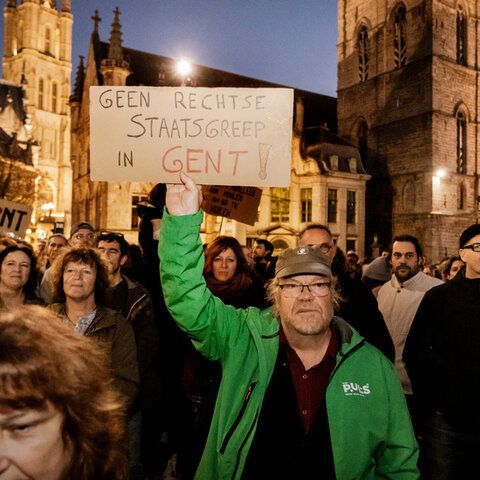De Oorzaak:
De Morgen contributes to noise pollution reduction
Noise surrounds us every day, but we seldom give it much thought. Yet, noise pollution has a serious impact on our health – contributing to thousands of deaths each year. De Oorzaak (The Cause), a ground-breaking investigation by De Morgen, aims to shed light on this issue and spark a long-overdue conversation about the impact of noise.
According to the European Environment Agency, noise contributes to the premature deaths of around 12,000 people across Europe each year. Additionally, 22 million Europeans experience severe stress from excessive noise levels, while 6.5 million struggle with chronic sleep disturbances.
These figures form the basis of De Oorzaak, the biggest survey ever conducted by De Morgen. We came across these figures in numerous European reports, yet noticed that local governments were doing little to address them. This was exactly what inspired us to launch a citizen science project in collaboration with the University of Antwerp and Antwerp University Hospital. The goal is to broadly survey Flemish residents about how ambient noise affects their lives, while also using in-home sensors in three cities – Antwerp, Ghent, and Leuven – to measure actual decibel levels.
As a newspaper, we strive to build a better society, and this is our way of making a real difference.
The sound
in your environment
Great Noise Survey
In September 2023, thanks to generous support from governments and private partners, De Oorzaak officially launched. In no time, nearly 9,000 Flemish participants took part in the first phase of the Great Noise Survey, documenting the noise they encountered in their surroundings. Last May, we took things up a notch by installing the first smart noise sensors on participants’ façades.
We will measure the ambient noise levels of nearly 2,000 residents in Antwerp, Ghent, and Leuven. Readers of De Morgen can view the measurements in real time through a specially designed dashboard. This lets you instantly see where the noise is loudest in the three cities at any given moment. By the way, participants need not worry about their privacy: the sensor is mounted on the façade and does not store any recordings. All data is instantly processed and converted into decibels thanks to trained algorithms.
Journalistic value
It’s remarkable to see how De Oorzaak comes to life not only in other media, which report on the results, but also in the streets, where our research is made visible through posters and sensors. For De Morgen, this holds great journalistic value – several journalists and infographics experts are working closely with academics on the project – and it also reflects our values. After all, as a newspaper we strive to build a better society; this is our way of making a real difference.
In June, we will analyse all the measurement results and citizen surveys, revealing not only what we’ve learned but also just how loud Flanders truly is. Preparations are already underway. To achieve this, we’ve established a visual storytelling team, consisting of five colleagues focused on discovering the most engaging and impactful digital presentation formats. Our goal is to deliver compelling digital content daily, prioritising smartphones. The culmination of this effort will be the conclusion of De Oorzaak, serving as a provisional highlight.
Remy Amkreutz
Remy Amkreutz
Editor-in-chief of De Morgen

More than news:
De Morgen brings readers and inspiring minds together
Events are not traditionally part of our core business, but at De Morgen , we believe a modern newspaper should offer more than just news. We also feel it is important to be a companion in the lives of our readers and visitors. This is why we’ve been collaborating with the independent Antwerp bookstore Stad Leest since October 2022. So far, we’ve organised several sold-out events, drawing between 350 and 2,000 attendees each evening, with notable guests including psychiatrist Dirk De Wachter, musician Warren Ellis, and authors Ilja Leonard Pfeijffer and Tommy Wieringa.
Last year, we had the pleasure of welcoming artist Rinus Van de Velde, writer Dimitri Verhulst, and historian Yuval Noah Harari. These ‘Evenings with’ events always give us an extra boost – what we usually only write or talk about becomes a reality right before our eyes. But more than that, they let us treat and surprise our readers in a special way.

De Morgen’s approach to the ‘far’ and ‘extreme’ right
Should we refer to Vlaams Belang as radical, far-right, or extreme right? And what about the communist PVDA? In a year dominated by elections, the topic also took centre stage in journalism, evolving into a broader discussion on the sixth floor of the DPG Media building in Antwerp.
Those who follow political scientists would choose ‘far-right’ when referring to Vlaams Belang. But those who gauge the mood in the newsroom are more likely to land on ‘extreme right’. The decision to ultimately choose far-right – partly at the urging of our political editors – was based on the academic definition: a party is considered extreme only if it is anti-democratic, which does not apply to Vlaams Belang. For exactly the same reason, we also chose to refer to the PVDA as ‘far’ left.
The tone of the paper – we believe in a better world – did notice a difference in attitude.
Does that mean we treated both parties exactly the same? To a certain extent. We took a highly critical approach to both PVDA and Vlaams Belang, and following the June elections, we invited both party leaders for in-depth interviews. The tone of the paper – we believe in a better world – did notice a difference in attitude. Which makes sense: while PVDA voices a far-left but generally inclusive message, Vlaams Belang tends to adopt rhetoric rooted in exclusion.
2024
The year in numbers
How high is our daily reach? How many articles do we write in a day and what rating does De Morgen get from its subscribers?
